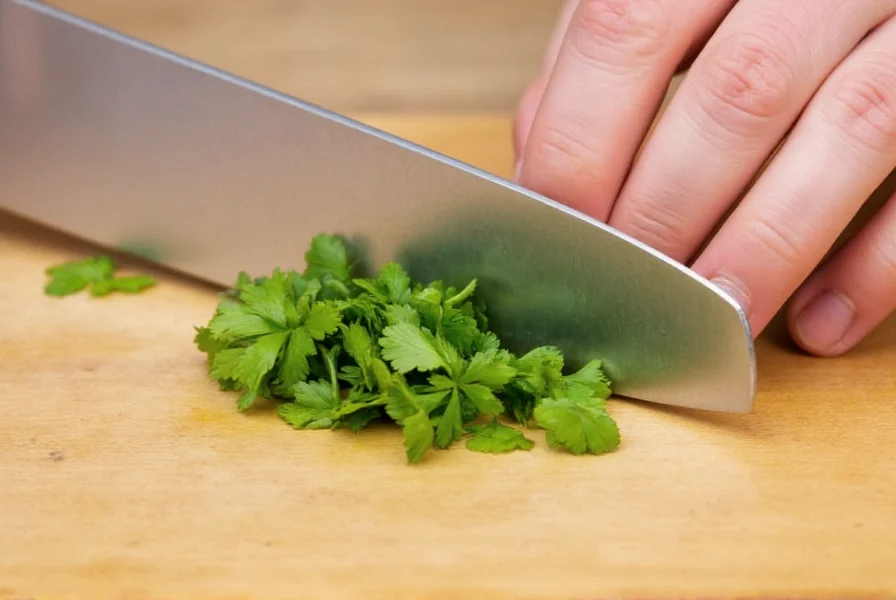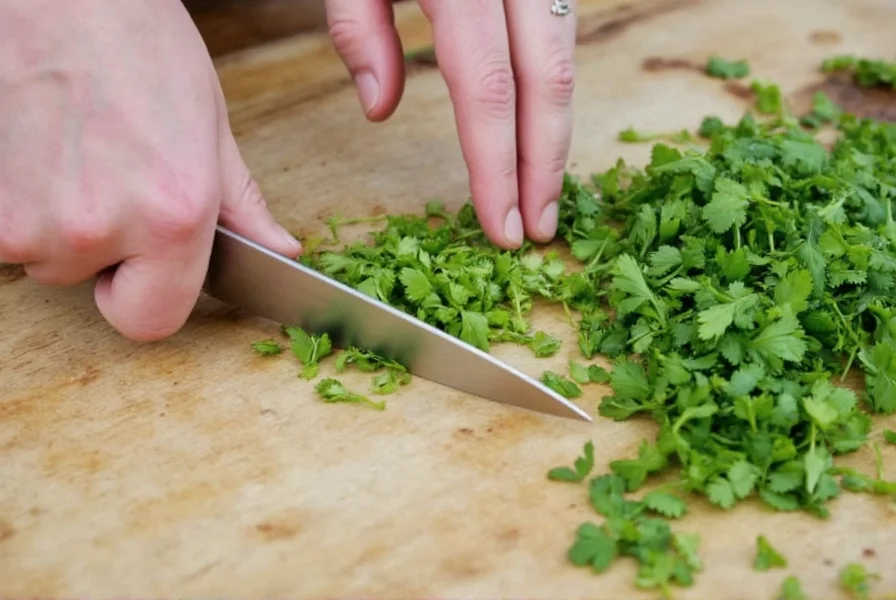Chopping coriander properly makes a significant difference in both flavor preservation and culinary results. Many home cooks unknowingly compromise this vibrant herb's delicate taste through improper cutting techniques. Understanding the science behind coriander preparation helps you maximize its bright, citrusy notes while minimizing bitterness.
Why Cutting Technique Matters for Coriander
Coriander (also known as cilantro) contains volatile oils that give it distinctive flavor. When you cut coriander, you're rupturing cell walls and releasing these compounds. The method you use determines whether you get bright, fresh notes or unpleasant bitterness. Proper technique preserves the herb's essential oils while minimizing oxidation that leads to flavor degradation.

Essential Tools for Cutting Coriander
Having the right equipment makes proper coriander preparation straightforward:
| Tool | Why It Matters | Alternative |
|---|---|---|
| Sharp chef's knife (6-8 inch) | Clean cuts minimize cell damage and bitter compounds | Herb scissors (less ideal) |
| Wooden or bamboo cutting board | Less abrasive than plastic, preserves delicate leaves | Glass board (not recommended) |
| Salad spinner | Removes excess water without bruising | Clean kitchen towel |
Step-by-Step Guide to Cutting Coriander Properly
1. Washing and Drying (The Critical First Step)
Improper washing introduces water that dilutes flavor and promotes spoilage. Fill a large bowl with cool water, submerge the coriander, and swish gently to remove dirt. Transfer to a salad spinner and spin thoroughly. For best results, lay between clean kitchen towels and press gently to absorb remaining moisture. Never skip this drying step—wet coriander won't chop properly and will become soggy.
2. Stem Separation (When and Why)
Many cooks discard coriander stems, but they contain concentrated flavor. For most recipes, use tender upper stems along with leaves. Only remove thick, woody lower stems. To separate:
- Gather small bunches (about 10 sprigs)
- Hold firmly at the base
- Slide fingers upward to strip leaves and tender stems
- Discard only the toughest lower portions
3. The Proper Chopping Technique
This is where most home cooks go wrong when learning how to cut cilantro without bruising:
- Gather washed, dried leaves into a loose pile (don't compress)
- Use a sharp knife with a rocking motion
- Make quick, clean downward cuts
- Stop when pieces reach desired size (usually 1/4 to 1/2 inch)
- Avoid sawing or pressing down hard
Over-chopping releases too many bitter compounds. For most applications, a rough chop preserves optimal flavor. The best knife for cutting coriander has a smooth blade edge—serrated knives crush rather than cut the delicate leaves.
What to Do With Coriander Stems
Don't waste these flavor powerhouses! Tender stems contain more concentrated flavor than leaves. Use them in:
- Curry bases and spice pastes (finely minced)
- Stocks and broths (tied in a bouquet garni)
- Marinades (blended with other ingredients)
- Smoothies (for subtle herbal notes)
Storage Tips for Freshly Cut Coriander
Once cut, coriander begins losing flavor rapidly. For how to store freshly cut coriander properly:
- Place in airtight container lined with paper towel
- Store in refrigerator crisper drawer
- Use within 24-48 hours for peak flavor
- Never store in water (promotes bacterial growth)
For longer storage, freeze chopped coriander in ice cube trays with a bit of water or oil. This preserves flavor better than drying, which significantly alters coriander's delicate profile.
Common Mistakes to Avoid
Learning the proper way to chop fresh coriander means avoiding these frequent errors:
- Using a dull knife - Crushes rather than cuts, releasing bitter compounds
- Over-chopping - Creates tiny pieces that turn brown and bitter quickly
- Cutting too far in advance - Flavor degrades within hours
- Washing without proper drying - Water dilutes flavor and causes sogginess
- Discarding all stems - Wastes flavorful, usable portions
How Much Coriander Equals One Bunch?
Understanding measurements helps with recipe planning. A standard supermarket bunch (about 2 ounces/55g) yields:
- 1 cup loosely packed leaves (stems removed)
- 1/2 cup finely chopped (stems included)
- 1/3 cup very finely chopped (for salsas or chutneys)
When following recipes, remember that how much coriander equals one bunch varies by region and season. Always adjust to taste rather than strict measurements.

When to Add Coriander to Dishes
The timing of adding chopped coriander affects flavor intensity:
- Raw applications (salsas, guacamole): Add just before serving
- Cold dishes (salads, raita): Add 15-30 minutes before serving to allow flavor infusion
- Hot dishes (curries, soups): Stir in during last 1-2 minutes of cooking
Excessive heat destroys coriander's delicate volatile oils, leaving only a grassy aftertaste. This explains why many traditional recipes specify adding fresh coriander at the very end.











 浙公网安备
33010002000092号
浙公网安备
33010002000092号 浙B2-20120091-4
浙B2-20120091-4